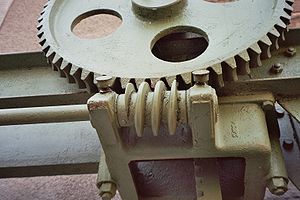Worm drive
The worm drive or "endless screw" was invented by either Archytas of Tarentum, Apollonius of Perga, or Archimedes, the last one being the most probable author.
[1] The worm drive later appeared in the Indian subcontinent, for use in roller cotton gins, during the Delhi Sultanate in the thirteenth or fourteenth centuries.
The invention of the worm drive is attributed by some to Archimedes during the First Punic War,[1] wherein the size of the ships being built necessitated a much larger crane than was available at the time.
[5]: 7 The crane developed for this purpose utilised a worm drive and several magnifying gears and was named the barulkon.
The description of this crane was recorded in the Library of Alexandria, and subsequent engineers would draw upon Archimedes' ideas until the first technical drawings of a worm drive were developed by Leonardo da Vinci;[6] the design was limited by the fact that metallic gears had not been invented by the advent of the 15th century, and the drive was never built in his lifetime.
[5]: 10 The modern applications of the worm drive began shortly after the introduction of more effective lubrication methods through closed gear housings.
Worm drives are used in presses, rolling mills, conveying engineering, mining industry machines, on rudders, and circular saws.
In addition, milling heads and rotary tables are positioned using high-precision duplex worm drives with adjustable backlash.
In the era of sailing ships, the introduction of a worm drive to control the rudder was a significant advance.
Plastic worm drives are often used on small battery-operated electric motors, to provide an output with a lower angular velocity (fewer revolutions per minute) than that of the motor, which operates best at a fairly high speed, in addition to being quieter than a drive with metal gears.
Examples of this may be seen in some hand-cranked centrifuges, blacksmithing forge blower, or the wind governor in a musical box.
[4]: 72 Worm wheels are first gashed to rough out the teeth then further refined closer to the final shape of the gear often within .5 millimetres (0.020 in).







